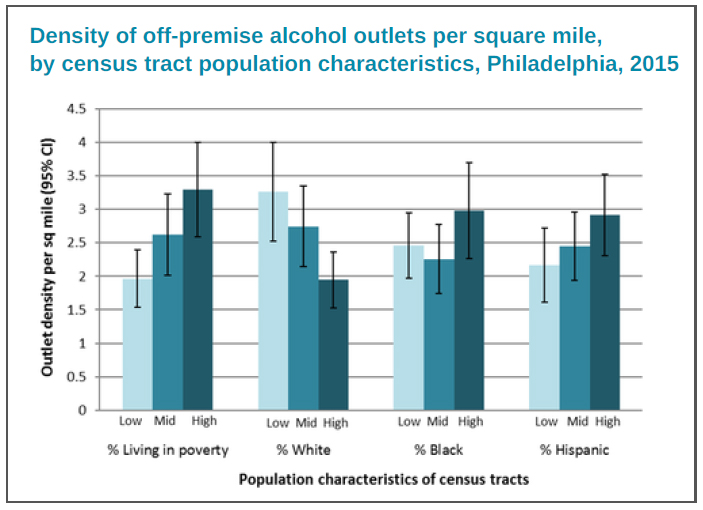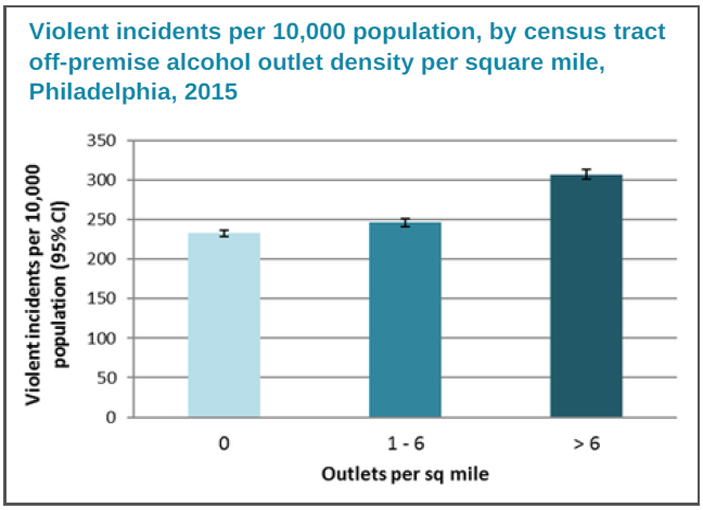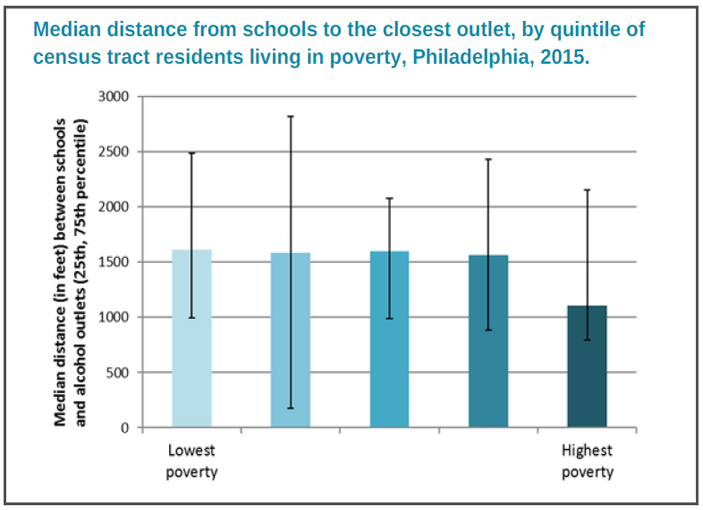Community Health Profile:
Alcohol Outlets and Violence In Philadelphia

Data Brief
January 2017
While individual diet and physical activity behaviors impact obesity, community and institutional settings may shape behaviors and precursors of obesity. Food insecurity, the uncertain ability to acquire sufficient and nutritious foods in socially acceptable ways, may at first seem counter to obesity — a disease often characterized by an excess of food. However, these two issues often coexist. Most importantly, food insecurity disproportionately affects those at the highest risk for obesity, including low-income households, women, and members of racial and ethnic minority groups.
Until recently in Pennsylvania, only state stores could sell wine and liquor and beer has mostly been sold at beer distributors. However, a new Pennsylvania law, HB1690 Liquor Reform Bill is gradually phasing-in changes that will increase the availability of alcohol in the state.
The new law allows grocery stores to apply for permits to sell wine and beer and convenience stores (including gas stations) to apply for permits to sell beer. New restaurant liquor licenses will be auctioned. State stores will continue to be the sole retailers of liquor (in addition to selling wine) but the new regulations enhance state store marketing. New state store marketing will include: more product promotion and discounting, state lottery sales to all state liquor stores (thereby increasing sales opportunities by attracting non-shoppers to alcohol outlets) and extended retail hours on Sunday evening.
Studies in other cities have shown that neighborhoods that have more stores selling alcohol have higher rates of violence, alcohol-related traffic crashes, and other public health and social problems. Research has shown that changes in alcohol laws to allow expanded sales are linked to changes in some of these outcomes. For example, in Washington State, recent relaxation of restrictions on alcohol sales, and resulting increases in sales in places like grocery stores and warehouse clubs, was followed by a 5-8% increase in assaults with each new outlet within a neighborhood.
This issue of the Urban Health Collaborative Data Brief describes the relationships among neighborhood characteristics, alcohol outlets, violent crime, and proximity to schools in Philadelphia. These data can be used to anticipate potential public health effects that might occur with expansion of alcohol sales in Philadelphia. We focus on stores that sell alcohol for consumption elsewhere (off-premise sales) because the public health impact of these outlets is greater than that of bars and restaurants (on premise sales).
Key Findings
There are more off-premise alcohol outlets per square mile in neighborhoods with higher poverty and in neighborhoods with higher percentages of Hispanic or African American residents.
In 2015, there were 296 off-premise alcohol outlets in Philadelphia. Mean neighborhood outlet density was 2.2 outlets per square mile (derived from census tracts, inter-quartile range 0-6 per square mile) which is much lower than comparable cities. For example, Baltimore and Los Angeles have >10 outlets per square mile. Nevertheless, Philadelphia outlet density varied across the city. In 50% of the city’s census tracts, there were no off- premise outlets whereas in approximately 25% there were at least 6 outlets per square mile.

The number of alcohol outlets per square mile was higher in census tracts with higher percentage of residents below the Federal poverty level and with higher percentages of residents who were Hispanic or black. The number per square mile was lowest in census tracts with the highest percentage of white residents.
For example, on average, in Philadelphia’s poorest (at least 32% of residents below the Federal poverty level) and least-White neighborhoods (less than 10% White), there were more than 3 outlets per square mile whereas in less poor (<16% of residents below the Federal poverty level) and more White neighborhoods (>57% white), there were less than 2 outlets per square mile.
Violence is more common in area with more stores selling alcohol.
Census tracts with higher densities of alcohol outlets had higher rates of violent incidents. For example, on average, in neighborhoods with more than 6 outlets per square mile, there were about 307 incidents per 10,000 population whereas in areas with no outlets, there were about 233 incidents per 10,000 population.
In 2015, there were 256 violent incidents per 10,000 people, of which 14% were firearm related. Positive correlations between alcohol outlet density and violence were similar whether the incidents involved a firearm or not.

Regardless of neighborhood poverty level, neighborhoods with more alcohol outlets have more violent incidents.
Violence was much more prevalent in poor neighborhoods. The rate of violent incidents per 10,000 population ranged from 130 per 10,000 in the lowest poverty quintile to 400 per 10,000 population in the highest poverty quintile.
Nevertheless, at all levels of neighborhood poverty, rates of violent incidents were higher in census tracts with higher densities of off-premise alcohol outlets. For example, in the neighborhoods with lowest poverty levels (<7% of residents below poverty level), violent incidents ranged from 111 per 10,000 population in the lowest alcohol outlet tertile to 168 incidents per 10,000 population in the highest tertile.
Similarly, in Philadelphia’s poorest neighborhoods (≥87% of residents below poverty level), violent incidents ranged from 384 per 10,000 population in the lowest alcohol outlet tertile to 448 incidents per 10,000 population in the highest tertile. A similar pattern was observed when violent incidents were restricted to firearm- related incidents.

Alcohol outlets are slightly closer to schools in neighborhoods with the highest level of poverty.
Among schools located in Philadelphia’s poorest neighborhoods (census tracts in the top 20% of the city’s poverty distribution), the median distance between schools and the nearest alcohol outlets was approximately 1100 feet; this was shorter than for schools located in other areas (median distance >1,500 feet).
Pennsylvania alcohol siting regulations require that alcohol outlets be located at least 300 feet from schools, which is roughly the same as prohibiting that an outlet share the same city block as a school. Outlet locations generally adhered to these regulations: 2.6% of schools (N=14 out of 538) had an off-premise alcohol outlet within 300 feet and this proportion did not vary by neighborhood poverty level. However, about 43% of schools had an alcohol outlet nearby which we define as having an off-premise outlet within about 3-4 blocks (about 0.25 miles).

Conclusions
The density of off-premise alcohol outlets is higher in Philadelphia neighborhoods with higher percentages of residents who are black, Hispanic, or living in poverty. Violent incidents, including those involving firearms, are higher in census tracts with higher rates of poverty. Regardless of census tract poverty levels, violent incidents slightly increase as the density of off-premise outlets increases, but the association of violent incidents with outlet density is weaker than the association with poverty. Finally, schools in Philadelphia’s poorest neighborhoods are slightly closer to alcohol outlets than schools in other areas.
The descriptive findings reported here regarding associations between alcohol outlet density and violent incidents generally align with findings from more rigorous observational studies conducted in U.S. urban areas that used statistical modeling to control for multiple confounders. Although the reasons are complex, in general, where alcohol is more available people drink more, and in some people alcohol intoxication leads to violent behaviors. Research has also shown that this connection varies among communities, making it difficult to predict how new state regulations allowing more stores to sell alcohol will affect levels of violence in Philadelphia. Regardless, the current concentration of alcohol outlets in low-income neighborhoods in Philadelphia suggests that the adverse effects are likely to be felt most by those who already suffer from social disadvantage.
As alcohol sales expand with changing regulations in Pennsylvania, community organizations, healthcare providers, and others who serve the most vulnerable should be prepared to address the potential health and social effects of greater alcohol use. Because greater concentrations of alcohol sales outlets near university campuses have been associated with higher levels of student drinking and campus rapes and assaults, universities should try to restrict off- premise alcohol sales near their campuses and strengthen their alcohol and violence prevention programs.
Recommendations
Public health experts affiliated with the U.S. Preventive Services Taskforce,[20, 21] U.S. Centers for Disease Control, [16, 22] universities and non-profit research institutes [16, 23-26] recommend a range of evidence-based policies to reduce alcohol-related harms.
Limit alcohol outlets and sales:
- Implement policies that re-zone or limit off-premise alcohol outlets and alcohol marketing; Restrict days/hours of alcohol sales;
- Increase the price of alcohol through taxes and minimum unit pricing; Enhance enforcement of laws prohibiting sales of alcohol to minors;
- Resist attempts to privatize alcohol outlets because it greatly increases alcohol outlet density and alcohol marketing. Reduce opportunities for alcohol-related violence and road crashes:
- Consider prior drunk driving convictions as one of the criteria for disqualifying persons from the purchase or possessionof firearms;
- Enhance penalties for carrying or using firearms while intoxicated;
- Implement strict automobile licensure requirements to reduce the risk of driving while alcohol-impaired. Educate, screen, treat:
- Build public support for limiting alcohol availability by disseminating information about the linkages between availability and higher incidents of alcohol-related harm;
- Promote public awareness regarding the harmful effects of heavy alcohol consumption (defined as more than one drink per day for women and more than two drinks per day for men), binge drinking (four or more drinks during a single occasion for women or five or more drinks during a single occasion for men), and alcohol drinking while pregnant or breast feeding.
- Expand screening for alcohol use, offer brief counseling for those with risky drinking patterns, and refer alcohol-dependent people for professional treatment;
- Enhance and expand treatment options for people dependent on alcohol.
Technical Appendix
Alcohol outlet data came from The Pennsylvania Liquor Control Board (PLCB) and represent all alcohol licenses as of May 2016. Alcohol outlets displayed in this report include only off-premise alcohol outlets. These included state- controlled liquor stores and PLCB Licenses ‘E’ (Eating place retail dispenser) and ‘D’ (Distributor).[5] As of May 2016, state-controlled stores were the only retailers permitted to sell wine and liquor for off-premise use. E licenses were permitted to sell beer (192 fluid oz or less) for off-premise use but must be equipped to sell food (these were mostly delis and corner stores where purchases were more likely to be consumed off-premise). D licenses were permitted to sell beer (264 fluid oz or more) for strictly off-premise consumption. Off-premise outlets were selected because violence has been linked to off-premise alcohol outlets more than to on-premise establishments (bars and restaurants).[2, 5, 6] On- premise establishments may exert stronger social control on the local environment via bouncers, and other staff.[2, 27] Alcohol outlet densities were calculated per square mile within a census tract.
Limitations in alcohol outlet data. While wine and liquor for off-premise consumption could only be purchased at state-controlled liquor stores, the delineation for sales of beer was less clear. PLCB also issues 'R' licenses (Restaurant Liquor) which includes more traditional restaurants and bars where on premise consumption of liquor, wine, and beer is permitted. These licenses also allowed (but did not require), off-premise sales of beer (192 fluid oz or less).
Unfortunately, available data did not distinguish R licensed establishments that sell beer for off premise consumption from those that did not. Therefore R licenses were not included as off-premise consumption outlets in our analyses. This is imperfect but was judged preferable to the larger measurement error introduced by including large numbers of R establishments (mostly restaurants) that sell primarily for on-premise consumption)
Crime data
Crime data came from the City of Philadelphia Police Department (available from OpenDataPhilly) for the calendar year of 2015. Violent crimes were defined as aggravated assault with and without firearm, robbery with and without firearm, rape, homicide, and other assaults (primarily simple assault and battery). Firearm incidents were defined as aggravated assault and robbery with a firearm and all homicides (see below). Rates per tract are displayed per 10,000 resident population (ACS 2010-2014). Violent crimes were selected because there was better/uniform reporting and indication of serious crimes. Data were downloaded from OpenDataPhilly in July 2016; the web data file date was the date of download (data are updated daily).
Limitations in classification of violent crimes. Violent crime was defined by grouping the following categories: homicide (criminal and gross negligence); aggravated assault (with and without firearm); other assaults (simple and minor assaults and battery); robbery (with and without firearm), and rape. In the dataset available, other assaults also included relatively low-frequency incidents: injury by culpable negligence; resisting or obstructing an officer; and stalking, intimidation, coercion, and hazing. We are unable to separate these incidents from the more serious bodily assaults, but given the low frequency of these, it is anticipated they would not exert a large impact on results.
Sensitivity analyses excluding all other assaults yield similar results to those shown.
Limitations in classification of firearm violence. Sensitivity analyses subset violence incidents into those with firearm. In the dataset available, use of firearm was differentiated for assault and robbery but not for homicide. Because most homicides are from gun-shot wounds, we classified homicide incidents as firearm incidents (note: in 2013, 81% of Philadelphia homicides were gun-shot wounds).
School data
School location data came from point locations of public (School District of Philadelphia), charter, private and archdiocesan schools in the City of Philadelphia. Data were downloaded from OpenDataPhilly in July 2016; the web data file had a last-update date 04/30/2015.
Census data
Census data came from the American Community Survey 2010-2014. Census tracts were used to describe neighborhood socio-demographics. Note that in Philadelphia, median population size per census tract is 3905 (25th- 75th 2893 – 5125). Crime incidents were calculated per 10,000 census tract population.
CITATION
Auchincloss AH, Buehler JW, Moore KA, Melly SJ, Diez Roux AV. Alcohol outlets and violence in Philadelphia. Urban Health Collaborative Data Brief Number 1, 2017. Dornsife School of Public Health, Drexel University: Philadelphia, PA.